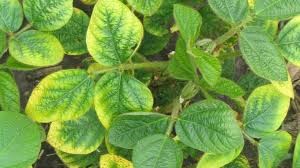Potassium is critical in determining soybean yields as it supports protein synthesis, turgor potential and stomatal function, and increases enzyme activation. Potassium deficiency starts by yellowing at the leaf tip and continues down the leaf margins to the base; symptoms start on older leaves first.

In soil, the majority of potassium is not readily available. Thus, applications must be made to support the plant. This is critical because once deficiency symptoms show up during the growing season a corrective treatment doesn’t return on the investment. For the future soybean crop, potassium fertilizers can be added to the soil during fall or spring fieldwork. If potassium is applied at planting it needs to be applied two inches to the side or two inches below the seed. If soil tests and tissues tests meet the critical levels, there could be lack of moisture or soil structural issues in the field. Also, K tests in dry soils vary substantially and are overestimated or underestimated until moisture is adequate.
Now a question to consider is how much nutrients does the crop remove? When calculating this you take the nutrient removal rate per bushel of yield times the actual yield. For soybeans the nutrient removal rate is 1.40 K20 per bushel. A combination of nutrient removal and soil testing should help determine the amount of nutrients to apply for future crops.
To analyze the payoffs in potassium applications I looked into Precision Planting® trials using different types of K20 products. The first product was SoyShot®, which contains a chelating agent Levesol®. The analysis of this product is 10% available phosphate, 10% soluble potash and 0.1% zinc. This product increases the availability of micronutrients and potassium in the soil. The trial applied 1-2 gallons per acre and had an average net gain of $11.92 per acre. Looking through the Precision Technology Institute 2018 trials there are a variety of soybean fertilizers used and all trials showed a substantial return on investment if the fertilizer was applied at planting or at V3 foliar stage.
Managing nutrient levels is challenging, but with tough commodity prices making sure the accurate amount is applied is critical to not overspending on inputs and maximizing yields.
Citation
Planting, P. (2018). PTI-Pontiac-2018-Summary-Results.pdf. Retrieved August 3, 2020, from https://irp-cdn.multiscreensite.com/25c4dd71/files/uploaded/PTI-Pontiac-2018-Summary-Results.pdf




 and then
and then